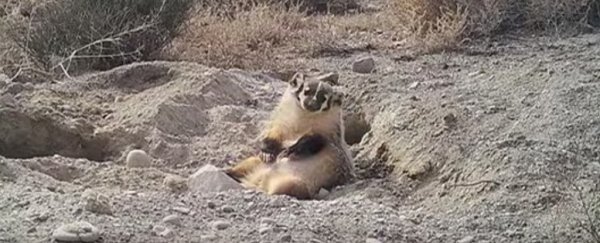It's not unusual for the American badger (Taxidea taxus) to dig a hole and bury food for later.
But one busy little badger has outdone itself by stealing a small cow carcass being used in a study on scavengers and burying the whole thing underground. Luckily for the researchers, the entire heist was caught on film.
Early last year, researchers from the University of Utah set out to study the winter behaviour of desert scavengers of the Great Basin, hoping to snap some footage of perhaps a few vultures, ravens, and bob-cats squabbling over the juvenile cow bodies they'd left as bait.
What they got instead was a dirty, dog-sized thief.
"When I first got there I was bummed because it's hard to get these carcasses, to haul them out and set them up," said researcher Evan Buechley.
"I thought 'Oh, well we've lost one after a week.'"
Little did Buechley realise at the time, but the missing beef was right under his feet - and it actually represents a never-before-seen-scale of behaviour for the species.
After a brief hunt around the area, the researcher noticed the disturbed soil where he'd left one of the seven small cow bodies staked to the ground, right in front of a camera trap.
"Right on the spot I downloaded the photos," said Buechley.
The film shows quite an industrious critter working around the clock to put his stash underground. Check out the cheeky beast in this time lapse film below.

Like many animals, American badgers preserve and hide away excess food from other scavengers by digging a hole and burying it, yet the behaviour was previously assumed to be limited to items smaller than its 60 to 75 centimetre (25 to 30 inch) body such as rabbits and rodents.
It doesn't seem to be a one-off example either, with another calf carcass in the same study being half-buried by another badger.
If only that one had the tenacity of its friend, it might have finished the job.
"Watching badgers undertake this massive excavation around and underneath is impressive," said another of the researchers, Ethan Frehner.
While the researchers hadn't set out to observe the badgers, their discovery did make for a fascinating opportunity to study the behaviour of a rarely seen animal.
"They're an enigmatic species. A substantial amount of their lifetime is spent either underground or a lot of nocturnal behaviour, so it's hard to directly observe that," said Frehner.
Other species in the mustelid family, including weasels, wolverines, and otters, don't have the right equipment for digging, but a large 1 metre (3.3 foot) relative of the badger called a fisher was noted to have been observed hiding a bear carcass under branches.
Given the scant resources in the sparse desert ecosystem, the researchers are now wondering what sort of impact this up-sized caching has on the ability for other scavengers to find food.
"The nutrients in a carcass can be very important for many different organisms in an ecosystem. So if badgers are monopolizing them and they have the ability to bury perhaps any mammal carcass in North America and they're present across much of the continent, the potential ecological implications are profound," Buechley said.
Of course we shouldn't anthropomorphise animals and assume they have human motivations or emotions.
But if that isn't a smug look on the little fellow's face, I don't know what is.
This research was published in Western North American Naturalist.
